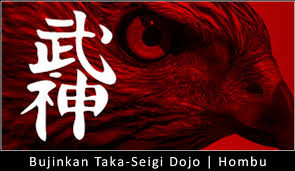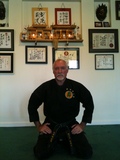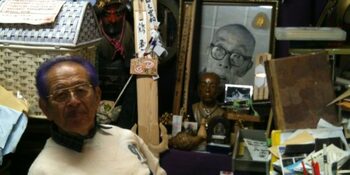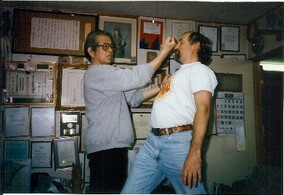
How I Train Alone?
10.12.18
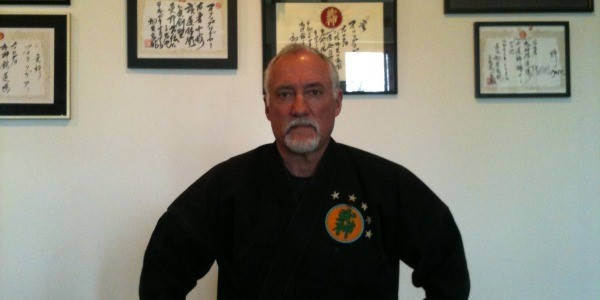
The Bujinkan’s method of training typically involves two or more training partners exploring techniques under the observation of a qualified Shidoshi (instructor). However, some of us may not live near a certified Bujinkan Dojo, or maybe we have to travel frequently for work, or for any number of reasons, training with a partner under supervision may not be an option. We here at the BTSD are constantly getting emails and messages from budoka all over the world asking us how they can practice this art alone.
It seems like this would be an easy question to answer, “Go do X, Y, & Z for 30 minutes every day…” But it’s not; Taijutsu is a very dynamic art that requires feedback from others in order to progress. The point of having an instructor is having someone more skilled critique your technique and point you to the next steps in your practice. Training partners provide instant feedback, you can literally feel the effectiveness of your movements through them.
When Hatsumi-Soke trained under Takamatsu-Sensei, he would take what he learned from his weekend classes and practice each movement 1,000 times. The key though, was that he was taught each technique directly and in person. But practicing incorrect techniques repetitively (without someone senior to critique you) will just ingrain bad habits and can be worse than training infrequently. To really progress, it is very important to find a good teacher, even if you can only train with them a few times per year. Soke says that there are many good senior instructors in the Bujinkan now, and that everyone should seek out a 15th dan to train with! He made a point of saying this at hombu class in November when I was visiting Japan for training.
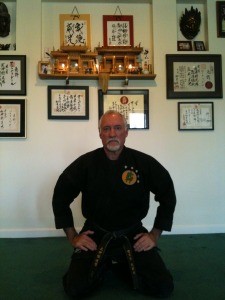
Training alone in my basement dojo
There are a couple of skills in the Bujinkan that lend themselves well to solo practice: Ukemi, Junan Taiso and striking. Practicing falls and tumbling provides immediate feedback from your environment. The ground acts as your Ukemi Sensei. The fundamentals of ukemi are simple enough that a reputable and well recorded video can pass on the basic skill. While not a glamorous as kicking ass, you are far more likely to need to be able to avoid injury from an accidental fall than from a violent attacker! In addition, having good ukemi skills will help you maximize face time you can get with your instructor and maybe even give you the chance to be their uke. And lets face it, Ukemi is what a Ninja does and its cool right? All that leaping, rolling, flying through the air and climbing noiselessly. Okay, maybe throwing stars.
If you are a beginner, practice your ukemi on a thick tumbling mat or on a soft grassy area. As your skill progresses, work up to harder and less even surfaces such as hardwood, composite track, sandy beach or hard pack ground. Video tape yourself to check your form. Tape a line on the floor to practice rolling in a straight line. When you can do this every time, blindfold yourself and see if you can still roll in a straight line. Pick up objects while rolling. Roll with a medicine ball in your hands. Use a flashlight and watch the light all the way through the roll (this helps train you not to close your eyes when rolling (other than to blink normally). Progress further to asphalt, concrete, carpeted stairs, etc. There are many programs available that teach fundamental ukemi skills. Members of takaseigi.com have access to an ever evolving library of training materials on this topic.
Junan Taiso (physical conditioning) is another area you can focus on alone or with minimal supervision. Strength and flexibility practices like yoga are great for improving your taijutsu. Climbing improves overall strength and agility. Moving in and out of Ichimonji, especially deep Ichimonji is great for developing flexibility and leg power. Putting small weights in each hand and going through the Go Gyo is great for developing power and improving focus. Tape a line on the floor and practice moving backward into 45 degree angles while alternating Migi and Hidari Ichimonji. Put a blindfold on to see if you can still move in correct angles and also judge where the walls are in relation to your position (this is done by sensing air pressure differences as you get closer to a wall). Train in front of a mirror or video yourself to check your form. Workout programs, such as CrossFit, Plyometrics, Tabata, Interval Training, Box Jumping, etc. can help with overall health and fitness. Improving strength and agility will enable you to learn some of the more ‘athletic’ techniques in the art. There are a number of very talented personal physical trainers in the Bujinkan, check with your teacher for a specific recommendation.
Striking with the body and with weapons is really good training that can be easily done alone. For developing power and good balance when punching and kicking use a medium to heavyweight bag to practice. The bag will give you immediate feedback on the power and precision of your strikes. Practice moving the bag in the direction you want it to go and stopping it when you want to. Develop the muscle memory of good strikes with many repetitions. Hang a small punching bag next to a heavy bag to work combinations of punches and kicks to very differently weighted targets (this replicates punching someone in the jaw and kicking them in the torso in combination). Practice your ukemi and strikes in combination. Roll up to a target, leap up and kick/punch at the same time. I developed my own drills on a heavy bag after watching one of Hatsumi Sensei’s videos where Nagato Shihan was striking targets. It goes like this: double palm strike (Happo Ken) to each side of the bag, head butt (Kikaku Ken), set stance, left block strike to the bag (Uchi Uke), punch with right hand (Fudo ken), collapse into a right elbow strike (Empi Ken), return strike with a right palm down edge hand strike (Ura Shuto). Then reset stance and repeat on the other side: block strike with the right hand, step in with a left punch, left elbow strike, then left edge hand strike. Training alone over time and you will develop some strike combinations of your own. Check your form in a mirror or video tape yourself and review after. This will give you good feedback on your form that you may not sense on your own.
Striking with weapons is also very easy. Its similar to practicing your punches and kicks, but with a weapon in your hands. Use a heavy bag (with a resilient cover) to practice the 9 directional strikes. This develops muscle memory, precision and power. Hang a tennis ball at chest or eye level to practice very precise strikes. Work to hit the ball with just the tip of the bo, jo and hanbo. Weighted chain training is similar, but you have to be careful of the weight wanting to bounce back on you. Work to gain precision and power while controlling where the weight by grounding it. Practice cutting air with a bokken or Tsuburito (a very heavy practice sword, kind of like a boat oar actually). Try to make that swoosh sound when cutting, but stopping the motion of the cut before going through the imaginary target. Cutting tatami mats and bamboo will teach you how to maintain the correct sword angle when cutting with a live blade. However, practicing with a live blade should NEVER be done alone for obvious safety reasons. Its too easy to seriously injure yourself with a live blade, even as an accomplished practitioner, so have a buddy when working with a live blade. Shuriken, axes, knives can all be thrown alone at targets. Whatch our Noguchi Sensei video of him throwing Bo Shuriken, then get a soft wood (pine is good) or mat target and start throwing. Watch the bounce back and its a good idea to have a spotter for safety.
I am often asked how to train alone. Training on your own is really important to becoming a better martial artist in any style. This is no different for Bujinkan students. As a general rule, I believe you should train twice as much on your own as you do in your dojo. We like to think we are “always” training, but are we? I wonder about that. I have been training on my own for many years to augment my training between trips to Japan and seminars with really good Shihan friends of mine. I can break my alone training down into two distinct venues: study and practice.
I study by reading Soke’s books, reviewing notes from past trainings, attending and hosting webinars, watching training dvds and of course, reviewing film from the TakaSeigi website. I enjoy pulling together threads of techniques from these sources to compare and contrast them to what I already know. I then prepare a short training outline or set of notes to run through in practice and to refer back to later. Sometimes I will write articles about certain weapons or techniques and use the references I find in my studies to benefit others. See my article on the bo for an example.
I practice by starting out with warm ups and ukemi, then progress to the Kihon Happo and Go Gyo. Then I like to do strikes to my padded pole or a free standing heavy bag. Punch, elbow, ura shuto, omote shuto, punch, elbow, ura shuto, omote shuto, etc., etc. Add in Sokuyaku keri, sampo keri, mawashi keri, yoko keri, ushiro keri, etc., etc. Then I grab a bo and strike the pole and do bo furi. Then a fundo. Then a metal sword and practice draw and cutting. Then I might grab a heavy bokken or tsuburito to do cutting drills for a few minutes. If I am outside I will throw shuriken, bo shuriken, knives and axes at the standing targets I have. Adding rolling to my throwing practice is always fun. I also like to swing a metal fundo and Kyoketsu Shoge at a wooden shoge man target for realism. I add in ukemi with weapons striking to develop a dynamic response.
I used to stand in front of the TV and practice deep Ichimonji a lot. I don’t do that anymore, but this is great training to develop hip flexibility and stamina for staying in deep Ichimonji. I also used to practice my rolls and falls on concrete. I don’t do that anymore either. I am getting older and prefer to roll on a nice soft mat these days. I know I can do it on concrete if I have to in part because I have put the time in over the years to practice it that way. Realistic training. Do you have to train for real in order to learn it well enough to be able to use it in combat? That’s the topic for a future article.
If you have a teacher, and are looking for more ways to progress and supplement your training; books, DVDs, and online videos have their place. The purpose of these materials isn’t to teach you from scratch; they exist to remind you of points you’ve already learned, and maybe to point out something you might have missed the first time. The online video library that we are constantly building for our takaseigi.com members serves this purpose. It’s designed to provide training points and inspiration from the best instructors in our art including Soke, Noguchi-sensei, Nagato-sensei and some of the best Gaijin Shihan training today. If you don’t have a teacher, find a 15th dan that you are comfortable training with and consider joining our website.
Now GO PLAY !!
Phillip Legare
Shihan Bujinkan
Budo and Shinken Taijutsu
BTSD Hombu, Maryland
“In Omnia – All In”
